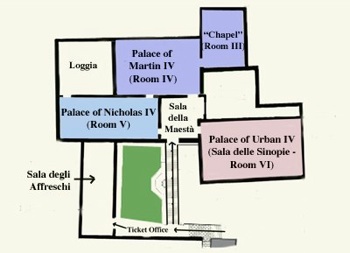
This was the main room of the palace of Pope Urban IV. It is now named for the under-drawings of frescoes (see below) that are exhibited on its walls (see below).
Sinopie (1356-64)
These sinopie (underdrawings for frescoes), which are exhibited around the walls of this room, came from the back wall and the first bay on the left in the Cappella del Corporale in the Duomo.
The frescoes in question were commissioned in 1356 from Giovanni di Buccio di Leonardello and Ugolino di Prete Ilario. Giovanni di Buccio soon left the team, leaving Ugolino di Prete Ilario in charge of it: he signed one of the frescoes on the back wall as Ugolino, painter of Orvieto, and dated it very precisely to 8th June 1364, which was presumably the date of completion of the entire programme of decoration.
Unfortunately, the frescoes were poorly restored in 1857-60 following the visit to Orvieto of Pope Pius IX. They were discovered during the restoration of the frescoes 1975-8 and were detached at that time.
[??] St Michael (ca. 1561)
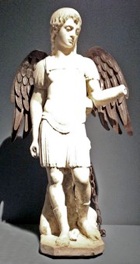
The figure depicts St Michael standing in front of a chained kneeling figure of a bearded man [the Devil ?]. Its iconography was obviously based on the figure (1544) of St Michael that Raffaello da Montelupo executed for the top of the Castel Sant' Angelo, Rome.
[??] Luca Signorelli and Nicolo d’ Agnolo Franchi (1504?)

[??] Madonna and Child (late 15th century)
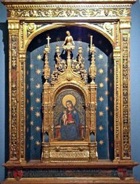
It seems unlikely that the present ornate frame was originally used for the panel: its depth suggests that it originally housed a sculpted relief. Its pinnacle is adorned with small sculptures in the round that depict the risen Christ flanked by half figures bearing symbols of the Passion. Its recent restoration has revealed that it was originally the central compartment of a polyptych, the other parts of which no longer survive.
The framed panel is now housed in an elegant gilded wooden tabernacle that has a fragmentary inscription on the bottom. This commemorates Baldassarre Leonardellii, the treasurer of the Opera del Duomo, and his wife Felice. His will (1484) refers to a chapel, the Cappella dei Ogni Santi, which he had built in the right transept.
[62] St Juvenal Altarpiece (ca. 1490)
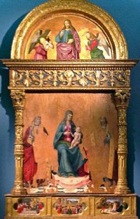
-
✴Christ blessing with angels, in the lunette;
-
✴the Madonna and child enthroned against a gold background, with (now ruined) figures of SS Juvenal and Sabinus to the sides; and
-
✴three scenes from the life of St Juvenal in the predella:
-
•Pope Damasus consecrates St Juvenal as Bishop of Narni;
-
•St Juvenal preaches Narni; and
-
•a pagan commits suicide after he has assaulted St Juvenal.
The main panel is attributed to Jacopo da Bologna, while members of the workshop that he directed in the Duomo in 1485-95 seem also to have been involved:
-
✴the lunette is attributed to Antonio del Massaro da Viterbo, il Pastura; and
-
✴the predella panels are attributed to Giovanni Francesco d' Avanzarano, il Fantastico.
[67-8] Statues of members of the Gualterio family
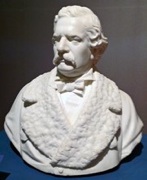
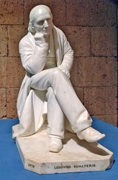
Filippo Antonio Gualterio Ludovico Gualterio
Enrico Gualterio gave these two statues to the museum in 1908:
-
✴a marble bust (19th century) by Santo Varni of Filippo Antonio Gualterio [67];
-
✴a full-length seated figure (1853) of Filippo’s father, Ludovico Gualterio that is signed by Giovanni Dupré [68].
[80] Assumption of the Virgin (1714)
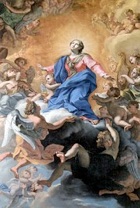
[81] Girolamo Curzio Clementini (ca. 1716)
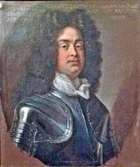
[83] Angel (early 16th century)
This painted terracotta figure came from the cloister of the Monastero del Buon Gesù. It might originally have been housed in the lunette above an altarpiece or a porta. It formed part of a larger work that might have depicted the Annunciation or perhaps a figure of Christ or the Virgin between two angels.



